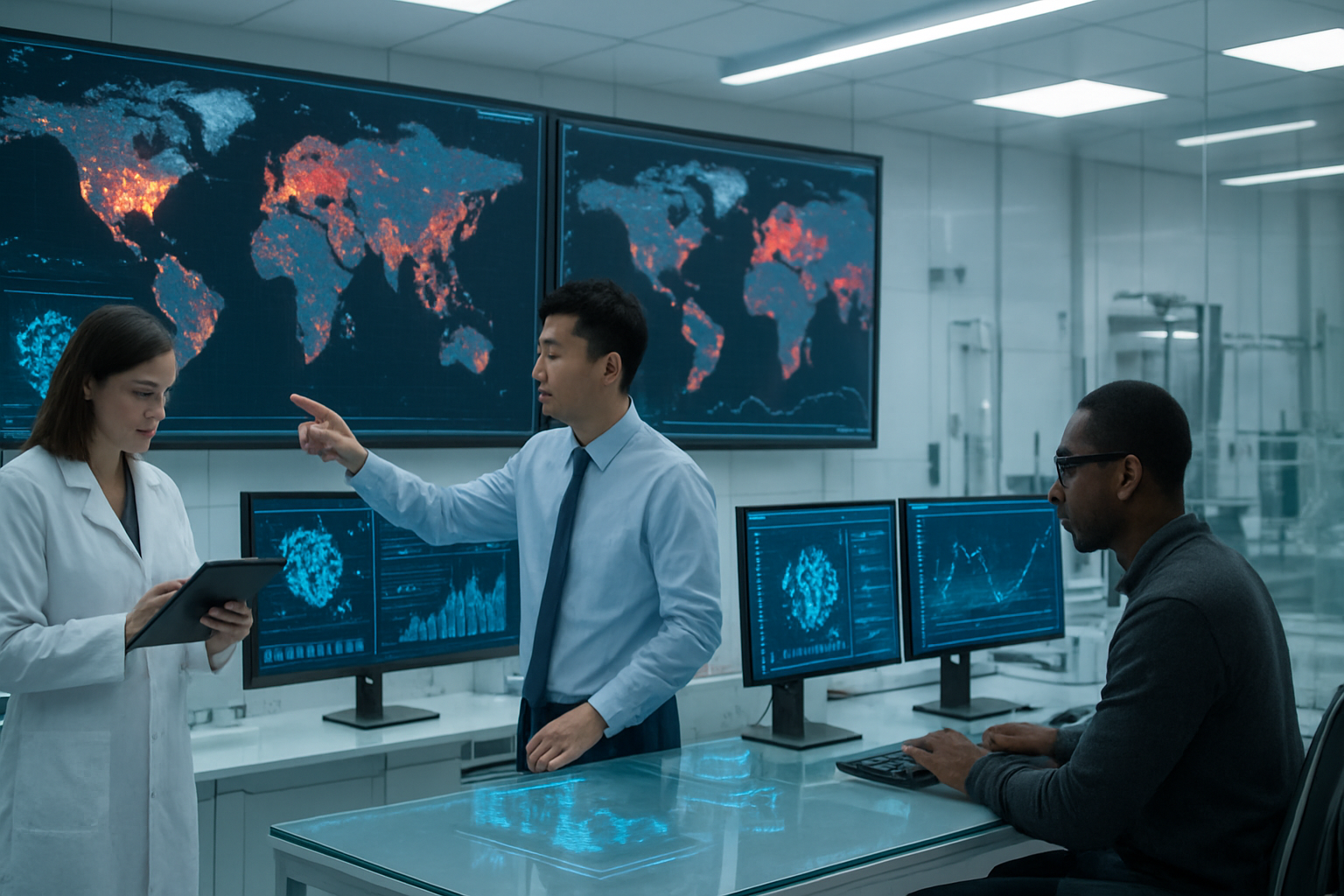
The pandemic changed everything we thought we knew about global health crises. While COVID-19 caught us off guard, AI pandemic response technologies are now reshaping how we’ll tackle future outbreaks. Artificial intelligence healthcare solutions have evolved from experimental tools to game-changing weapons that can predict, prevent, and respond to pandemics faster than ever before.
This guide is for healthcare professionals, policymakers, tech leaders, and anyone curious about how AI is revolutionizing pandemic preparedness. You’ll discover how machine learning transforms our ability to stay ahead of health crises and why pandemic AI solutions could mean the difference between chaos and control next time.
We’ll explore how AI disease prediction models can spot outbreaks before they spread widely, giving us precious time to respond. You’ll also learn about breakthrough AI diagnostic tools that can identify infections with incredible accuracy, plus contact tracing artificial intelligence systems that track transmission chains in real-time without overwhelming human resources.
These aren’t distant possibilities – they’re happening now, and they’re setting the stage for a completely different approach to global health security.
AI-Powered Disease Prediction and Outbreak Prevention

Advanced Epidemiological Modeling Using Machine Learning
The evolution of epidemiological modeling has reached a transformative milestone with the integration of machine learning technologies. Traditional epidemiological models like SIR (Susceptible-Infectious-Recovered) and SEIR (Susceptible-Exposed-Infectious-Recovered) have long served as the foundation for understanding disease transmission dynamics. However, these conventional approaches rely on differential equations with fixed assumptions and historical parameters, significantly limiting their adaptability during rapidly evolving outbreak scenarios.
AI-driven epidemiological models represent a paradigm shift by incorporating sophisticated machine learning techniques, including recurrent neural networks and graph neural networks, to analyze complex temporal and spatial patterns. These advanced systems demonstrate remarkable capability in processing vast amounts of real-time data sources, including mobility trends, web searches, and social media activity, substantially improving both forecasting accuracy and adaptability compared to traditional methods.
PandemicLLM, a groundbreaking multi-modal large language model architecture developed by Johns Hopkins and Duke universities, exemplifies this revolutionary approach. This innovative system outperforms traditional time-series models by integrating diverse data streams including policy information, genomic surveillance data, and behavioral patterns. The model’s success lies in its ability to reason with complex inputs rather than treating prediction merely as a mathematical problem, considering factors such as recent infection spikes, new variants, and mask mandates.
Real-Time Disease Transmission Pattern Analysis
The analysis of disease transmission patterns has been revolutionized through AI’s capacity to process and correlate multiple data streams simultaneously. Traditional surveillance systems often process each data source independently, creating critical gaps in understanding outbreak dynamics and missing crucial cross-source correlations that could provide comprehensive threat assessments.
Modern AI systems address this “connecting dots” problem through sophisticated natural language processing capabilities that synthesize information across diverse sources. For instance, when a local hospital reports a surge in respiratory cases while social media discussions highlight concerns about flu-like illness, and simultaneously the World Health Organization requests information about unusual pneumonia cases, an LLM-based epidemic intelligence system can correlate these seemingly disparate signals into coherent warnings.
Real-time transmission pattern analysis leverages advanced multilingual NLP capabilities to monitor global online sources, including news reports, social media trends, and official health communications. This approach significantly reduces detection time compared to manual surveillance methods, enabling public health authorities to identify emerging patterns before they escalate into full-scale outbreaks.
The integration of physics-informed neural networks, such as SIR-INN, demonstrates how AI can combine real-time data with established epidemiological frameworks. These systems integrate live influenza data into modified SIR models, offering both interpretability and predictive accuracy while maintaining the theoretical foundation of traditional epidemiological modeling.
Early Warning Systems Through Predictive Analytics
AI-powered early warning systems have emerged as critical components of modern pandemic preparedness, leveraging predictive analytics to identify potential outbreaks before official confirmation. These systems analyze vast amounts of unstructured data from multiple internet-based sources, including social media platforms, online news articles, and search queries, to detect early warning signals.
Several pioneering platforms demonstrate the effectiveness of this approach. HealthMap, launched in 2006, continuously monitors global online news for infectious disease reports through automated surveillance. EPIWATCH, an AI-driven early warning system, scans public health reports and social media platforms, providing alerts ahead of official announcements. Similarly, Epitweetr, developed by the European Centre for Disease Prevention and Control, monitors Twitter feeds for signs of infectious disease events.
The success of BlueDot during the COVID-19 pandemic exemplifies the potential of AI-driven early warning systems. This commercial analytics platform detected the initial unusual pneumonia outbreak in Wuhan before public health agencies raised alarms, demonstrating the superior speed and accuracy of AI-powered surveillance compared to traditional methods.
These predictive analytics systems incorporate credibility scoring mechanisms, source validation checks, and anomaly detection algorithms to filter misinformation and distinguish credible signals from misleading social media content. Advanced systems implement hybrid approaches that combine structured healthcare data with carefully filtered open-source inputs, providing richer contextual insights while minimizing the risk of false alarms driven by virality or engagement-driven amplification.
Optimized Vaccine Distribution Strategies
AI-driven vaccine distribution optimization represents a critical advancement in pandemic response capabilities, though current implementations remain limited in their integration with real-time surveillance systems. The optimization of vaccine distribution requires sophisticated algorithms that can analyze multiple variables simultaneously, including population demographics, disease transmission patterns, healthcare infrastructure capacity, and logistical constraints.
Machine learning models excel at processing complex spatial and temporal data to identify optimal distribution strategies that maximize coverage while minimizing transmission risk. These systems can dynamically adjust allocation strategies based on emerging outbreak patterns, ensuring that vaccines reach the most vulnerable populations and high-risk areas with maximum efficiency.
The integration of epidemiological forecasting with resource allocation optimization enables proactive rather than reactive distribution strategies. AI systems can predict where outbreaks are most likely to occur and pre-position vaccine supplies accordingly, significantly reducing response times when new cases emerge.
However, real-world adoption of AI-driven vaccine distribution optimization faces significant challenges, including regulatory constraints, interoperability issues with existing healthcare systems, and policy misalignment. Addressing these barriers requires stronger collaboration between AI developers, healthcare providers, and public health agencies to ensure seamless integration into existing clinical workflows and distribution networks.
The future of optimized vaccine distribution lies in developing integrated systems that combine outbreak prediction, real-time surveillance, and resource optimization within cohesive decision-support frameworks. These systems must incorporate ethical considerations, ensuring equitable distribution while maximizing overall public health impact through scientifically-informed allocation strategies.
Revolutionary AI Applications in Vaccine Development

Accelerated Vaccine Design Through Protein Structure Prediction
AI technologies revolutionized vaccine design by enabling rapid analysis of viral genomic data and protein configurations. Machine learning vaccine development algorithms analyzed vast amounts of viral genomic sequences, identifying potential vaccine targets in a fraction of the time traditionally required by human researchers. For COVID-19 vaccines like Pfizer-BioNTech and Moderna, artificial intelligence healthcare applications proved critical in rapidly combing through viral genomes to identify optimal targets for triggering strong immune responses.
The identification of the spike protein as the primary target for COVID-19 vaccines exemplifies AI’s transformative impact. AI-enabled computational models simulated various molecular configurations of the spike protein, allowing scientists to quickly assess which configurations were most likely to provoke effective immune responses. This computational approach enabled researchers to model and optimize potential vaccine candidates, dramatically reducing timelines from concept to clinical trials from years to months.
Deep learning architectures, including convolutional and recurrent neural networks, generative adversarial networks, and variational autoencoders, proved instrumental in multiepitope vaccine design. These sophisticated AI pandemic response systems generated novel proteins that could serve as potential vaccines, demonstrating the technology’s capacity to create entirely new therapeutic approaches.
AI-Driven Clinical Trial Optimization and Data Analysis
Clinical trials underwent significant transformation through AI-powered optimization systems. Artificial intelligence improved participant sorting based on individual risk factors including age, pre-existing health conditions, and geographical location. This enhanced recruitment efficiency allowed researchers to focus on high-risk populations most likely to benefit from vaccines, ensuring trials reflected diverse populations most affected by the pandemic.
AI-driven predictive analytics enhanced trial accuracy and outcomes through real-time monitoring capabilities. AstraZeneca utilized AI-powered systems to monitor participant data continuously, enabling rapid identification of anomalies or potential side effects. This real-time surveillance allowed researchers to make quick adjustments to trial protocols when necessary, ensuring participant safety while maintaining research momentum.
Deep learning models facilitated adaptive clinical trial simulations, enabling researchers to predict trial outcomes and optimize study designs before implementation. These simulations helped identify potential challenges and solutions early in the process, reducing costs and improving success rates.
Reverse Vaccinology and Target Identification Platforms
Machine learning approaches dominated antigen discovery and epitope prediction tasks through reverse vaccinology methodologies. This AI-driven approach examines pathogen genetic sequences to identify antigens capable of eliciting immune responses, fundamentally changing how researchers approach vaccine target identification.
Traditional machine learning approaches—including random forests, support vector machines, gradient boosting, and logistic regression—proved essential for antigen discovery processes. AI-driven multi-omic integration accelerated epitope mapping, shrinking discovery timelines by months compared to conventional approaches.
The integration of computational speed with biological complexity through AI pandemic solutions redefined possibilities in therapeutic development. These platforms enabled researchers to systematically analyze pathogen genomes and predict which components would generate the most effective immune responses.
Rapid Screening of Vaccine Components and Efficacy Prediction
AI technologies streamlined vaccine component screening through sophisticated predictive modeling systems. Machine learning algorithms analyzed multiple factors affecting vaccine efficacy, including molecular interactions, immune system responses, and population-specific variables.
Deep learning architectures enabled rapid assessment of vaccine components through pattern recognition and predictive analytics. These systems could evaluate thousands of potential combinations quickly, identifying the most promising candidates for further development.
AI-driven predictive analytics extended beyond component screening to manufacturing optimization and supply chain operations. These systems optimized temperature-controlled “cold-chain” logistics, ensuring vaccine integrity throughout distribution networks. Real-time monitoring systems powered by AI algorithms tracked temperature conditions throughout supply chains, helping distributors maintain strict cold chain requirements essential for mRNA vaccines.
The integration of AI across vaccine development processes demonstrated artificial intelligence’s transformative potential throughout the entire vaccine lifecycle, from initial design through manufacturing and distribution.
Enhanced Diagnostic Capabilities Through Artificial Intelligence

High-Accuracy COVID-19 Detection Using Medical Imaging
Now that we have covered disease prediction and vaccine development, we turn our attention to one of the most transformative applications of AI pandemic response technology: enhanced diagnostic capabilities through artificial intelligence. The integration of AI diagnostic tools in medical imaging has revolutionized how healthcare professionals detect and diagnose COVID-19, fundamentally changing the landscape of pandemic healthcare delivery.
The emergence of artificial intelligence healthcare solutions has addressed critical challenges in COVID-19 detection, particularly when traditional testing methods faced limitations in availability, speed, or accuracy. Through sophisticated machine learning algorithms, medical imaging has become a powerful complement to conventional diagnostic approaches, offering rapid screening capabilities that can process thousands of images with remarkable precision.
Deep Learning Models for Radiological Data Processing
The development of deep learning models for radiological data processing represents a significant advancement in pandemic AI solutions. These sophisticated algorithms have been designed to analyze various imaging modalities, including chest X-rays, computed tomography (CT) scans, and ultrasound images, each offering unique insights into COVID-19’s pulmonary manifestations.
Research has revealed interesting patterns in how AI experts have approached different imaging modalities. While AI developers have predominantly focused on chest X-ray analysis, clinical practitioners have emphasized the importance of CT and ultrasound imaging. This disparity highlights the need for better alignment between artificial intelligence healthcare research and clinical practice requirements.
The technical architecture of these deep learning models incorporates convolutional neural networks (CNNs) and other advanced machine learning techniques specifically optimized for medical image analysis. These systems can identify subtle patterns and anomalies in lung imaging that might be challenging for human radiologists to detect consistently, particularly during high-volume screening scenarios typical of pandemic conditions.
Biomarker Identification with Over 90% Precision
The pursuit of high-precision biomarker identification through AI diagnostic tools has yielded remarkable results, with some systems achieving accuracy rates exceeding 90%. These AI pandemic response systems analyze radiological features that serve as digital biomarkers, identifying specific patterns associated with COVID-19 infection.
Despite the impressive technical achievements, comprehensive systematic reviews of the literature have revealed significant challenges in translating research success into clinical practice. Analysis of over 400 research manuscripts published throughout 2020 demonstrated that while numerous studies reported high accuracy rates, the vast majority faced limitations regarding their practical clinical utility.
The focus of AI research has been heavily skewed toward diagnostic applications, with approximately 72% of AI papers concentrating on diagnosis rather than other critical aspects such as prognosis or treatment guidance. This concentration on diagnostic capabilities reflects the urgent need for rapid, accurate screening tools during the early phases of the pandemic.
Automated Clinical Decision Support Systems
Previously, we’ve seen how individual AI diagnostic tools can achieve high accuracy, but the integration of these tools into comprehensive automated clinical decision support systems represents the next evolution in pandemic preparedness technology. These systems combine multiple AI algorithms to provide healthcare professionals with comprehensive analytical support for clinical decision-making.
However, the transition from research prototypes to clinically viable automated systems has proven challenging. Systematic analysis has shown that only a small fraction—approximately 2.7%—of published AI research has achieved the maturity level necessary for practical clinical implementation. This limited clinical readiness underscores the complexity of developing robust healthcare AI applications that can function reliably in real-world clinical environments.
The development of effective automated clinical decision support systems requires addressing several critical factors: integration with existing healthcare infrastructure, validation across diverse patient populations, and compliance with regulatory requirements. These systems must demonstrate not only technical accuracy but also practical utility in supporting healthcare professionals during high-pressure pandemic scenarios.
With this in mind, the future development of AI diagnostic tools must prioritize clinical relevance alongside technical performance, ensuring that artificial intelligence healthcare solutions can effectively bridge the gap between research innovation and practical patient care applications.
Smart Contact Tracing and Infection Monitoring

Digital Detective Networks for Real-Time Chain Reaction Tracking
Contact tracing artificial intelligence transformed pandemic surveillance through sophisticated digital detective networks that monitored transmission pathways in real-time. In Guangdong province, AI algorithms processed vast amounts of data to trace and predict transmission paths with remarkable precision, achieving significant reductions in local transmission rates within the first month of implementation. These AI-powered systems operated as comprehensive tracking networks, analyzing complex data streams to identify infection chains and potential exposure events across entire populations.
The COVID-19 Analysis and Control Platform developed by Nanjing Edge Intelligence Research Institute exemplified the power of these digital detective networks. This platform aggregated and analyzed real-time data from multiple sources, creating a comprehensive picture of viral transmission patterns. The system’s ability to process diverse datasets enabled health authorities to implement precise containment strategies based on accurate transmission tracking rather than broad-spectrum lockdowns.
Bluetooth and GPS-Based Exposure Identification
AI pandemic response systems leveraged Bluetooth and GPS technologies to create sophisticated exposure identification networks. These technologies enabled automatic detection of close contacts through proximity sensing, while GPS data provided crucial location-based intelligence for understanding transmission patterns. The integration of these technologies with AI algorithms allowed for immediate identification of potential exposure events and rapid notification of at-risk individuals.
Major cities employed these AI-based systems at transport hubs and densely populated areas, using thermal imaging and facial recognition to efficiently identify symptomatic individuals and enforce quarantine measures. This multi-layered approach combined passive monitoring through Bluetooth proximity detection with active surveillance systems, creating a comprehensive exposure identification network that helped curb the spread in high-risk environments.
Privacy-Conscious Surveillance Technologies
The deployment of AI contact tracing systems required careful balance between public health needs and privacy protection. AI-driven health and travel codes monitored the virus’s spread while implementing privacy-conscious approaches to surveillance. These systems used anonymized data processing techniques and decentralized architectures to protect individual privacy while maintaining effective contact tracing capabilities.
Pandemic AI solutions incorporated privacy-preserving algorithms that could track transmission patterns without compromising personal data security. The systems employed federated learning approaches and differential privacy techniques, allowing for effective outbreak control while addressing ethical and privacy challenges faced during rapid implementation. This approach demonstrated that effective surveillance could coexist with privacy protection when properly designed and implemented.
Social Graph Analysis for Outbreak Control
AI diagnostic tools extended beyond individual contact tracing to comprehensive social graph analysis, mapping complex networks of social interactions to predict and control outbreaks. These artificial intelligence healthcare systems analyzed social connections, movement patterns, and interaction frequencies to identify high-risk clusters and transmission hotspots before they became major outbreak centers.
The AI systems forecasted population movements and enabled early warning capabilities by analyzing social networks and behavioral patterns. This approach proved particularly effective in predicting where the virus might spread next, allowing health authorities to implement targeted interventions. The social graph analysis capabilities enabled AI-powered transport robots and disinfection systems to be deployed strategically in areas identified as high-risk transmission nodes, maximizing the effectiveness of containment measures while minimizing resource expenditure.
AI-Driven Strategic Decision Making During Health Crises

Large Language Models for Policy Strategy Evaluation
AI-driven strategic decision-making during health crises has revolutionized how policymakers evaluate and implement interventions. Large language models serve as powerful analytical tools that process vast amounts of epidemiological data to assess policy effectiveness. These advanced AI systems analyze complex relationships between different intervention strategies and their potential outcomes, enabling health authorities to make informed decisions based on comprehensive data analysis.
AI supports decision-making at all stages—from data collection to intervention planning—by predicting long-term health system needs and disease outcomes. The integration of artificial intelligence healthcare solutions allows for rapid evaluation of multiple policy scenarios simultaneously, providing policymakers with evidence-based recommendations for pandemic response strategies.
Computational models based on AI and machine learning, such as integrated SIR-LSTM hybrid models, predict disease transmission patterns and assess intervention impacts to inform strategic decisions. These sophisticated systems enable real-time policy evaluation, allowing governments to adapt their responses as pandemic conditions evolve.
Regional Recommendation Systems for Targeted Interventions
AI pandemic response systems excel at developing region-specific intervention strategies by analyzing local transmission patterns and population dynamics. Machine learning algorithms improve understanding of disease propagation patterns across different geographical areas, enabling customized approaches that account for regional variations in demographics, healthcare infrastructure, and social behaviors.
AI forecasts disease spread in specific regions using ensemble, deep learning, and hybrid models with varying accuracy levels, providing policymakers with location-specific insights. These regional recommendation systems process diverse data sources including epidemiological records, mobility patterns, and healthcare capacity metrics to generate targeted intervention strategies.
The technology leverages federated learning approaches that disperse training data across sources like hospitals while maintaining performance close to centralized data systems. This distributed approach ensures that regional recommendations remain relevant to local conditions while benefiting from broader epidemiological knowledge.
Resource Allocation Optimization for Healthcare Systems
Now that we have covered policy evaluation frameworks, resource allocation optimization represents a critical application of AI in pandemic preparedness technology. AI-enabled systems analyze healthcare system capacity, patient flow patterns, and supply chain logistics to optimize resource distribution during health crises.
These intelligent systems predict healthcare demands by analyzing multiple variables including:
- Hospital capacity utilization rates
- Medical equipment and supply requirements
- Healthcare workforce availability
- Patient admission and discharge patterns
AI technologies guide resource allocation through data-driven decision-making processes that optimize vaccine distribution, medical supply deployment, and healthcare personnel assignments. The systems continuously monitor resource utilization patterns and adjust allocation strategies based on real-time demand fluctuations.
Machine learning models achieve over 85% accuracy in predicting healthcare resource needs, enabling proactive rather than reactive resource management. These predictive capabilities allow healthcare systems to maintain adequate capacity while avoiding resource waste during critical periods.
Public Trust Maintenance Through Transparent AI Decisions
With this in mind, maintaining public trust through transparent artificial intelligence applications becomes essential for successful pandemic response. AI-based decision-making systems must balance algorithmic efficiency with public understanding and acceptance of recommended interventions.
Transparent AI decisions in healthcare contexts require clear communication of how algorithms process data and generate recommendations. Public health authorities use AI-driven surveillance networks to collect and analyze information while ensuring transparency in their decision-making processes.
The challenge lies in presenting complex AI-generated insights in accessible formats that build rather than erode public confidence. Effective transparency strategies include:
- Clear explanation of data sources and analytical methods
- Regular public reporting of AI system performance metrics
- Open communication about system limitations and uncertainties
- Involvement of community stakeholders in AI system development
AI systems must address privacy and data security considerations while maintaining transparency about their operations. This balance becomes particularly important in contact tracing applications where AI leverages Bluetooth, GPS, and social graph analysis to identify potential contacts efficiently while addressing legitimate privacy concerns.
The systematic approach for developing transparent AI systems involves defining clear objectives, ensuring comprehensive data representation, maintaining logical coherence in recommendations, and conducting regular validation testing to build and maintain public trust in AI-driven pandemic response strategies.
Global Pandemic Preparedness Through Federated AI Solutions

Knowledge Transfer to Low and Middle-Income Countries
With this in mind, federated AI systems present a transformative opportunity for bridging healthcare disparities between developed and developing nations during pandemic preparedness efforts. The decentralized approach of federated learning enables low and middle-income countries (LMICs) to participate in collaborative AI model development without requiring extensive computational infrastructure or exposing sensitive health data.
The hierarchical federated learning framework allows LMICs to leverage pre-trained models and knowledge aggregated from global healthcare networks while contributing their unique regional disease patterns and demographic data. This collaborative approach ensures that pandemic forecasting models account for variations in population density, healthcare infrastructure, and social behaviors specific to different regions, ultimately improving prediction accuracy across diverse geographical areas.
Through federated AI partnerships, developing nations can access sophisticated predictive modeling capabilities that would otherwise be financially and technically prohibitive. The privacy-preserving nature of federated learning ensures that countries can share insights while maintaining data sovereignty, addressing concerns about digital colonialism and data exploitation that often arise in traditional centralized AI approaches.
Distributed Learning Systems for Data Privacy Protection
Now that we have established the importance of global collaboration, the distributed learning architecture addresses critical privacy concerns that have historically limited international healthcare cooperation. Federated AI enables collaborative model training on decentralized datasets without transferring sensitive health data, ensuring compliance with regulations such as HIPAA and GDPR across different jurisdictions.
The Byzantine-resilient information-theoretic federated learning (ByITFL) approach strengthens security by incorporating trust mechanisms and information-theoretic privacy scoring. This advanced framework ensures that malicious or compromised nodes cannot significantly impact model performance or compromise patient data privacy. The system maintains robust protection against various attack vectors while enabling seamless collaboration between healthcare institutions.
Homomorphic encryption techniques, integrated within the federated framework, provide an additional layer of security by allowing computations on encrypted data. This cryptographic approach ensures that even during model aggregation processes, raw patient information remains completely protected, addressing the paramount concern of data security in healthcare applications.
Virtual Randomized Controlled Trial Capabilities
Previously, we’ve seen how federated learning transforms data sharing paradigms, and now we can explore how it revolutionizes clinical research methodologies. The federated AI framework enables virtual randomized controlled trials (RCTs) that can span multiple institutions and countries without compromising patient privacy or data security.
These virtual trials leverage decentralized datasets to create more diverse and representative study populations, addressing historical biases in clinical research that often underrepresent certain demographic groups or geographical regions. The hierarchical structure allows for multilevel model aggregation that enhances statistical power while maintaining the integrity of individual institutional datasets.
The blockchain-based smart contracts ensure transparent and verifiable coordination among participating research nodes, creating an immutable audit trail for trial protocols and results. This technological integration addresses concerns about research transparency and reproducibility while enabling rapid deployment of clinical studies during pandemic emergencies.
International Coordination Through Shared AI Platforms
With this framework in place, international pandemic coordination becomes significantly more effective through shared federated AI platforms that respect national sovereignty while enabling global collaboration. The decentralized architecture allows countries to maintain control over their healthcare data while contributing to collective intelligence efforts for pandemic preparedness.
The system facilitates real-time monitoring and early detection capabilities by continuously processing data from hospitals, clinics, and mobile health devices across participating nations. This global surveillance network can detect early signs of outbreaks and predict trends without requiring countries to share sensitive health information directly.
Resource allocation optimization becomes possible through collaborative AI models that analyze hospital admission rates, bed occupancy, and medical supply usage across different regions. This intelligence enables more efficient distribution of critical resources such as vaccines and medical supplies, ensuring equitable access across diverse communities regardless of their economic status.
The federated approach addresses regulatory and ethical concerns that often complicate international health collaborations, as different countries can participate according to their specific legal frameworks while contributing to the global pandemic response effort. This flexibility is essential for building trust and ensuring widespread adoption of AI-driven pandemic preparedness systems across diverse geopolitical landscapes.

The integration of AI across pandemic response has fundamentally transformed how we approach global health crises. From AI-powered disease prediction models like SIR and SIS that optimize vaccine distribution, to revolutionary applications in vaccine development that accelerate design at digital speed, artificial intelligence has proven indispensable. Enhanced diagnostic capabilities through deep learning algorithms achieving up to 100% accuracy in COVID-19 detection, smart contact tracing systems, and AI-driven strategic decision-making have collectively reshaped our pandemic preparedness landscape.
As we look toward future health challenges, the potential of federated AI solutions and large language models to support real-time decision-making offers unprecedented opportunities for global pandemic preparedness. The roadmap is clear: AI can help us transition from reactive chaos to proactive control, enabling more flexible and situation-specific responses while maintaining public trust. The technology exists, the frameworks are being developed, and with continued global research collaboration, AI will become our most powerful ally in navigating the next pandemic with precision, speed, and strategic insight.

